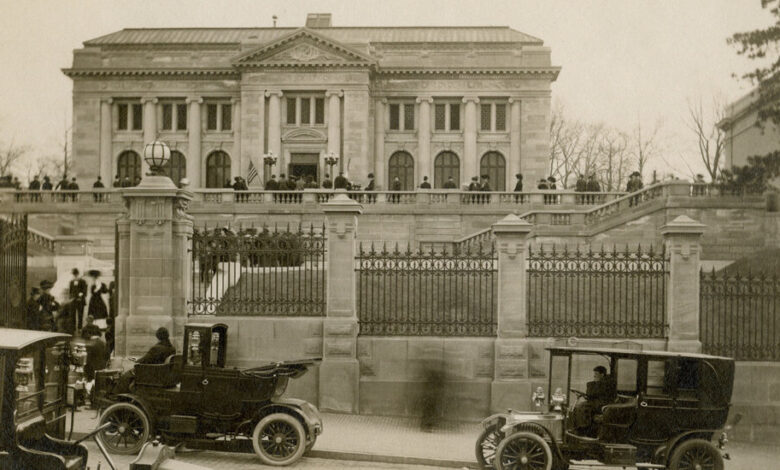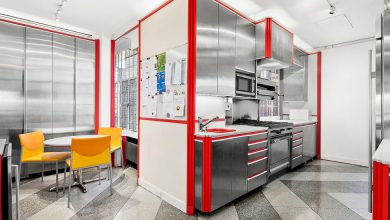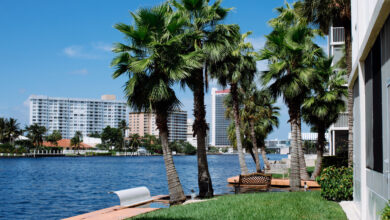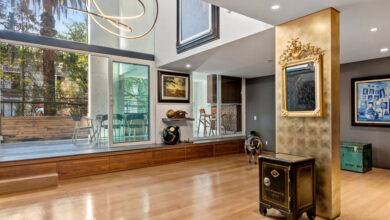Audubon Terrace Is Extending an Olive Branch to Its Neighborhood

[ad_1]
If you are heading down Upper Broadway in Washington Heights, past the smoke shop and the eyebrow-threading salon and Chipotle, and you look to the right at 156th Street, you’ll see a cloister of imposing cultural buildings largely cut off from the neighborhood.
This is Audubon Terrace, an august assemblage of neo-Italian Renaissance structures, which rose around a rectangular courtyard between 1904 and 1930 on part of the former estate of the naturalist John James Audubon.
In their early years, the terrace and its founding institution, the Hispanic Society of America, were wide open to what was then a largely suburban neighborhood, approached from the north by a grand double staircase. But the open space on 156th Street was filled in by a new building in the mid-1920s, leaving a narrow opening at Broadway as the main entrance.
Ever since, the cultural complex, which occupies almost an entire city block between Broadway and Riverside Drive East, has presented high walls to the neighborhood on both 155th and 156th Streets. The gated entrance on Broadway has little signage to beckon anyone inside, and in recent years, most of the terrace’s buildings have been largely closed to the public.
But change is coming. Two Audubon Terrace institutions — the renamed Hispanic Society Museum & Library and the American Academy of Arts and Letters — are pursuing renovations and expanded programming intended to open the terrace to the mostly Latino neighborhood and to the city at large. Through the years, the institutions have sometimes been seen as aloof from their neighbors, with the Hispanic Society even drawing fire in the 1990s for what critics saw as its leaders’ Eurocentric dismissiveness of the surrounding, largely Dominican community.
The efforts at inclusivity will gain momentum in March when the doors of the Hispanic Society’s architecturally dazzling main building are opened to the public for the first time in six years. The society, which has two buildings on the south side of the terrace and one on the north, is the repository of an extraordinarily rich collection of more than half a million items relating to the art and cultures of the Spanish- and Portuguese-speaking world. The institution, and Audubon Terrace as a whole, were the vision of Archer M. Huntington, a collector and ardent hispanophile who inherited vast wealth from his stepfather, a railroad magnate.
But the signature space of the society’s main building, the arcaded, Spanish Renaissance-style Main Court, which features luscious terra-cotta details and a portrait of the Duchess of Alba by Francisco de Goya y Lucientes — known more commonly as Goya — has been closed for renovations since 2017. So has the gallery that houses Vision of Spain, 14 monumental paintings from the Valencian master painter Joaquín Sorolla y Bastida.
In March, timed to commemorate the centennial of Sorolla’s death, the society will reopen the restored and updated Main Court, the Sorolla Gallery and the Upper Terrace, an open-air space that looks out over El Cid and other fine sculptures. Eye-catching new signage will be built into the Broadway gate.
The renovations, which are part of a more extensive master plan, are the work of the Beyer Blinder Belle and Selldorf architecture firms, the team behind the current expansion of the Frick Collection.
The museum will also mount several exhibitions this year, the first larger-scale shows in these spaces in more than a decade. One exhibit, “Picasso and La Celestina,” will mark the 50th anniversary of the Spanish painter’s death by exploring his relationship with one of the most famous seminal novels in Spanish literature.
At the far western end of the terrace, the American Academy of Arts and Letters, an honor society, is also upgrading its three-building campus to improve its poor circulation and accessibility. Planned improvements include the renovation of its auditorium, already well underway. Starting this year, the academy will gut much of its East Building to create artists’ studios for an anticipated studio residency program, the first such effort in the academy’s history.
The institution has traditionally opened its doors to the public only three months a year, for exhibits of art made either by its own members or by winners of its prestigious awards. Beginning next fall, however, the group plans to offer year-round programming for the first time in over 50 years.
“We want to make more connections to the local community and to New York City more broadly,” the academy’s executive director, Cody Upton, said. “We hope to have more exhibits in our galleries that appeal to, and reflect that we are in, Washington Heights.”
Perhaps the group’s most ambitious renovation goal is also the most controversial: The construction of a corridor connecting its two original neo-Italian Renaissance buildings, which face each other across the terrace. The corridor would run along the far west lot line of the complex, with a new, wheelchair-accessible main entrance at its center.
But this envisioned corridor has run afoul of neighbors in three Riverside Drive apartment buildings, two directly to the west of the terrace and a third across 156th Street. The corridor design presented to the public in the fall of 2021 showed a glass wall facing the terrace but a bronze-clad wall facing west, which neighbors protested would deprive dozens of them of the light and views they have enjoyed for decades.
At a follow-up meeting in October, Mr. Upton reported that a revised plan would replace the bronze western wall with glass. But neighbors were perturbed that the academy intended to go forward with the corridor and were frustrated not to be shown any new drawings or materials samples.
Mr. Upton said in an email that the new design would shrink the height of the corridor’s western wall at its center to 17 feet, a reduction of two and a half feet. He said he hopes to show these revised plans to neighbors this month.
Because Audubon Terrace is a historic district, the academy is required to present its updated plans at public hearings before Community Board 12 and the city Landmarks Preservation Commission, which must approve the work.
At the Hispanic Society, a central aim of the renovations is to open the museum both physically and figuratively, making the terrace and museum not only wheelchair-accessible for the first time, but actively inviting the community into a cultural enclave where area residents have not always felt welcome.
“My primary goal is really not only to get the museum back to life, but to get the life to the museum,” said Guillaume Kientz, a former curator of Spanish and Latin American art at the Louvre Museum in Paris, who became the Hispanic Society’s director two years ago. “It’s a major undervalued and underused organization, and I want to restore it to the place it used to have in the beginning of the 20th century.”
He added that while he intended the institution’s reach to be global, “our primary responsibility as a museum is to engage with our immediate community.”
Such hospitality toward the neighbors has not always been on display at the society.
In 1993, Theodore Beardsley, then its director, told ArtNews magazine that his rationale for not promoting the museum to its surrounding community was that its residents had a “low level of culture.” These sentiments, in concert with a description of the neighborhood by George S. Moore, then the society’s president, as “nontaxpaying slums,” prompted protests by local Dominicans. At one such demonstration, protesters chased Mr. Beardsley across Audubon Terrace, chanting, “Beardsley, racista!”
A year later, Mr. Beardsley was gone from the society, but in 2006 the institution’s board of trustees voted unanimously to leave the neighborhood altogether for an undetermined new location downtown. It was a short-lived plan.
The society’s past standoffishness extended beyond Washington Heights as well.
“For a long time, as is well known, the Hispanic Society turned its back not only on its own community, but on the community of museums,” said Philippe de Montebello, the former director of the Metropolitan Museum of Art, who was elected chairman of the society’s board of trustees in 2015. “Scholars had difficulty even getting in. The notion of a visitor meant a nuisance. It would interrupt a curator from doing their research.”
Mr. de Montebello noted, however, that an imbalance in the collection that favored the art of Spain had been redressed over the past couple of decades by the acquisition of a considerable amount of Latin American art.
The appointment of Mr. Kientz as director has given new vigor to the society’s engagement with Washington Heights, about two-thirds of whose residents are Hispanic, according to a Social Explorer analysis of a 2016-2020 census survey. Forty-five percent of the neighborhood is of Dominican descent, 6 percent Mexican and 5 percent Puerto Rican.
“We have an opportunity here to rebuild something together,” Mr. Kientz said. “We want to be an amenity to them and we want to be an opportunity for them. So this is very much the spirit of the renovation and the partnerships that we have been building together since I arrived.”
One intention of this outreach is to support the work of contemporary artists. To this end, the society has pursued a fertile partnership with the Northern Manhattan Arts Alliance, a nonprofit group known as NoMAA.
Last year, the society displayed an exhibit of new murals — commissioned by HBO and originally organized by HBO and NoMAA at the United Palace theater — that documented the contributions of the Latinx diaspora to Upper Manhattan from the 1890s to today; Boricua College, the society’s neighbor on the terrace, also participated. In addition, the society hosted a show in its East Building that traced the evolution of “In the Heights,” the musical and film by the Upper Manhattan native Lin-Manuel Miranda.
The society also partnered with NoMAA to issue the groups’ first annual open call for artwork to be installed on the terrace during summer. The winner, “Orange Cube, 2014,” an interactive installation by the Argentina-born Upper Manhattan artist Marta Chilindron, will go on view in June.
“It’s really a beautiful and timely way of marrying our institutions,” said Niria E. Leyva-Gutiérrez, NoMAA’s executive director.
“They’ve traditionally been used to dealing with dead artists,” she said of the Hispanic Society, “so here we are with these living, breathing artists. I think they’re really interested in finding ways to do that, specifically because they are committed to figuring out how best to engage with the community.”
For weekly email updates on residential real estate news, sign up here.
[ad_2]
Source link






